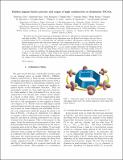Hidden kagome-lattice picture and origin of high conductivity in delafossite PtCoO2
Abstract
We study the electronic structure of delafossite PtCoO2 to elucidate its extremely small resistivity and high mobility. The band exhibits steep dispersion near the Fermi level despite the fact that itis formed mainly by Pt d orbitals that are typically localized. We propose a picture based on two hidden kagome-lattice-like electronic structure: one originating from Pt s + px/py orbitals, and the other from Pt d3z^2-r^2 + dxy/dx^2y^2 orbitals, each placed on the bonds of the triangular lattice. In particular, we find that the underlying Pt s + px/py bands actually determine the steepness of the original dispersion, so that the large Fermi velocity can be attributed to the large width of the Pt s + px/py band. In addition, the kagome-like electronic structure gives rise to "orbital-momentum locking" on the Fermi surface, which reduces the electron scattering by impurities. We conclude that the combination of the large Fermi velocity and the orbital-momentum locking is likely to be the origin of the extremely small resistivity in PtCoO2.
Citation
Usui , H , Ochi , M , Kitamura , S , Oka , T , Ogura , D , Rosner , H , W. Haverkort , M , Sunko , V , King , P D , Mackenzie , A P & Kuroki , K 2019 , ' Hidden kagome-lattice picture and origin of high conductivity in delafossite PtCoO 2 ' , Physical Review Materials , vol. 3 , no. 4 , 045002 . https://doi.org/10.1103/PhysRevMaterials.3.045002
Publication
Physical Review Materials
Status
Peer reviewed
ISSN
2475-9953Type
Journal article
Collections
Items in the St Andrews Research Repository are protected by copyright, with all rights reserved, unless otherwise indicated.

